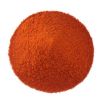Cayenne Facts
Red Pepper Facts
Did you know?
Cayenne is known as “the king of medicinal herbs,” because it has been used for thousands of years to treat a variety of health problems.
Did you know?
The hottest part of the pepper is not the seed but the section closest to the stem because it has the concentration of capsaicin.
Applications
Cayenne pepper is best known for its bright red color and flavor in Mexican cuisine, where it’s used to season robust spicy sauces, meat marinades and dishes like enchiladas, tacos and fajitas.
Origin
Cayenne peppers belong to the nightshade family, Solanaceae. It is a cultivar of Capsicum annuum and is believed to have originated in Cayenne, French Guiana.
21 Vitamins and Minerals
-
Calcium
-
Carotene
-
Choline
-
Copper
-
Folate
-
Iron
-
Lutein
-
Magnesium
-
Manganese
-
Phosphorus
-
Potassium
-
Riboflavin
-
Selenium
-
Sodium
-
Thiamin
-
Vitamin A
-
Vitamin B-6
-
Vitamin C
-
Vitamin E
-
Vitamin K
-
Zinc
Applications
Adds color and heat to sauces, salad dressings, seasoning mixes, luncheon and deli meats, mixes, crackers, snack seasonings and as a garnish.
Origin
Red pepper belongs to the family Solanaceae and is made from the dried fruits of plants from the genus capsicum. Its origins can be traced back over 6,000 years to South America.
22 Vitamins and Minerals
- Calcium
- Carotene
- Choline
- Copper
- Folate
- Iron
- Lutein
-
Magnesium
-
Niacin
- Phosphorus
- Potassium
- Riboflavin
- Selenium
- Sodium
-
Thiamin
-
Vitamin A
-
Vitamin B-6
-
Vitamin C
-
Vitamin E
-
Vitamin K
-
Zinc
Red Pepper Cultivation
Chilli (Capsicum annuum L. and Capsicum frutescens L.) belongs to the Solanaceae family. Believed to be a native of Mexico and Peru, it was also cultivated in Central and South America. The chilli fruit is hollow with many seeds. There are more than 200 different varieties of chilli with varying levels of pungency, colour, flavour and shape and size. Chilli seeds also have pungency which is due to the chemical compounds called capsaicinoids. The colour of Red chillies is due to the colouring compound, capsanthin.
After it is harvested, cleaned and dried, the chili peppers are cut and milled for further processing in various applications like seasonings, ready meals and snacks.
The cutting of the chili pepper is an important pre-step in the milling process. The chilli pods are hit by the rotating cutting blades of the rotoplex granulator and crushed to uniform particles with a fineness < 2mm. The visual appearance and product size can be adjusted by the perforation size in the product outlet.
Chilli flakes are generally made from a single type of red pepper and used to express that pepper's flavor. Crushed red pepper are made from a mix of red peppers from the capsicum annum family.





